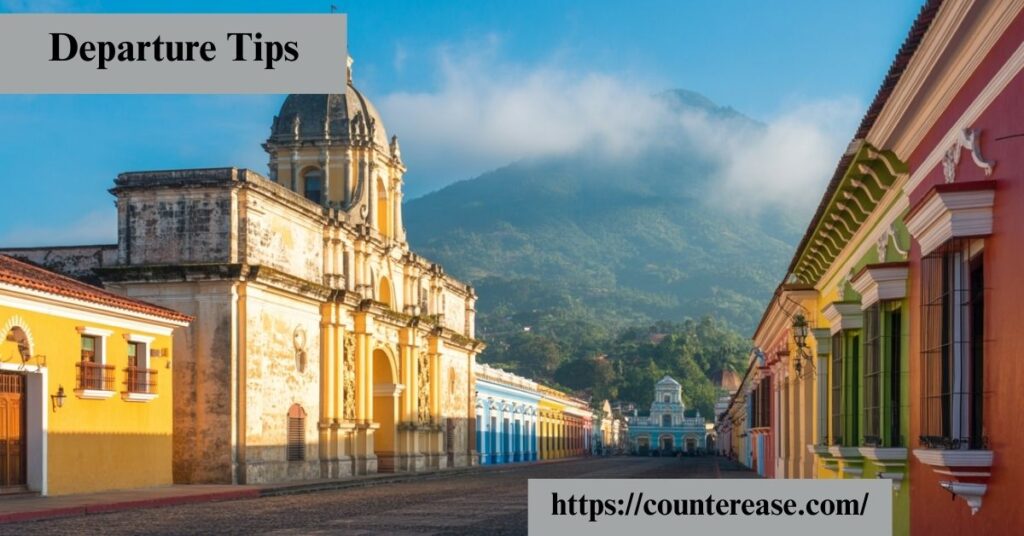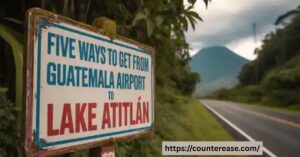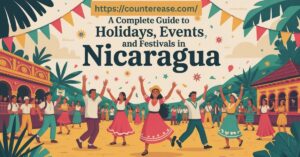A travel-guide-Guatemala-City serves as a complete resource for exploring the vibrant capital of Guatemala, offering insights into its history, culture, and modern life. As the largest city in Central America, Guatemala City combines colonial landmarks, bustling markets, and a lively urban spirit. This travel guide guatemala city helps travelers navigate its dynamic neighborhoods, from the historic streets of Zona 1 to the modern nightlife of Zona 10, ensuring an authentic yet safe experience.
Beyond its urban charm, Guatemala City captivates visitors with its blend of tradition and progress. Imagine colorful street art in Zona 4, rich Maya heritage showcased in world-class museums, and culinary adventures in local eateries. The city may not always make the top of tourist itineraries, but it delivers a unique pulse and energy unmatched by other destinations in the region.
This travel-guide-Guatemala-City highlights everything from transportation tips and safe zones to cultural hotspots and nearby excursions. Whether planning a short stopover or a longer stay, the travel guide guatemala city unlocks the capital’s hidden gems and practical essentials. It becomes the ideal companion for anyone eager to experience Guatemala City in its truest form—alive, authentic, and unforgettable.
Your Complete Journey Through Central America’s Hidden Capital
Guatemala City breaks every stereotype you’ve heard about Central American capitals. Sure, it’s not the postcard-perfect colonial gem like Antigua. But this sprawling metropolis of 3 million people offers something most tourists never experience: an authentic glimpse into modern life in Guatemala.

Most travelers treat Guatemala’s capital as a layover stop before heading to Lake Atitlán or the ancient ruins of Tikal. That’s a mistake. This largest city in Central America pulses with energy, street art, incredible food, and cultural treasures that rival any destination in the region.
Essential Pre-Trip Knowledge
When to Visit Guatemala City
Guatemala City’s climate stays remarkably consistent year-round thanks to its 4,920-foot elevation. The dry season from November through April offers the best conditions for exploring this cultural and economic centre.
Dry Season Advantages:
- Clear skies for volcano day trips
- Perfect street art walking weather in Zona 4
- Outdoor markets and festivals
- Less humidity for museum visits
The rainy season (May-October) shouldn’t scare you away. Afternoon downpours clear quickly, and you’ll find fewer crowds at major attractions like the Museo Nacional de Arqueología y Etnología.
See Also: Exploring The Markets In Kabul, Afghanistan
Budget Breakdown for Guatemala City
Guatemala City offers incredible value compared to other Central American capitals. Here’s what you can expect to spend daily:
| Budget Level | Daily Cost (USD) | Includes |
|---|---|---|
| Budget | $25-35 | Hostel, street food, public transport |
| Mid-range | $50-75 | Boutique hotels, restaurant meals, Uber |
| Luxury | $100-150 | Modern/upscale amenities, fine dining, private tours |
The Guatemalan Quetzal (GTQ) trades at approximately 7.8 to 1 USD. ATMs are abundant in tourist-friendly areas like Zona 10 and Zona 1.
Getting to Guatemala City
La Aurora International Airport (GUA)
La Aurora International Airport sits just 4 miles from Guatemala City’s center in Zona 13. This airport area offers modern facilities that might surprise first-time visitors to Central America.
Airport Amenities:
- Free WiFi throughout terminals
- Currency exchange booths (better rates in the city)
- International food chains and local restaurants
- Duty-free shopping with Guatemalan coffee and textiles
Immigration Process: U.S. citizens need only a valid passport for stays up to 90 days. The process typically takes 15-20 minutes during peak hours.
Overland Border Crossings
Many travelers combine Guatemala City with broader Central American adventures. Popular overland routes include:
- Mexico Border (El Carmen/Talismán): 5-hour bus journey to the capital
- Belize Border (Melchor): Direct connections via Flores
- Honduras Border (El Florido): Route through Copán ruins
Transportation Within the City
Navigating the Zona System
Guatemala City divides into 25 numbered zones. Understanding this system is crucial for getting around safely and efficiently. The zona system might seem confusing initially, but it’s actually quite logical.
Key Tourist Zones:
- Zona 1 (Historic Centre): Colonial architecture and government buildings
- Zona 4: Artistic/bohemian district with vibrant street art
- Zona 9: Modern business district
- Zona 10 (Zona Viva): Main tourism hub
- Zona 13: Airport area and industrial zone
Uber and Transportation Options
Use Uber or official taxis for all your transportation needs in Guatemala City. This isn’t just convenience advice—it’s essential safety guidance.
Uber Coverage:
- Available 24/7 in all major zones
- Average wait time: 5-8 minutes
- Cost: $2-5 for most tourist destinations
- English-speaking drivers common in Zona 10
Official Taxis vs Street Taxis: Always choose registered taxi companies over random street pickups. Official taxis display proper licensing and company information. Many hotels arrange pre-arranged shuttle services for airport transfers.
Public Transport Reality Check
Honestly? Avoid public transport as a tourist in Guatemala City. The iconic “chicken buses” (converted school buses) offer authentic local experiences but present safety concerns for visitors carrying cameras and valuables.
The Transmetro bus rapid transit system serves locals well but isn’t tourist-friendly due to overcrowding and pickpocketing risks.
Where to Stay in Guatemala City
Zona 1 (Historic Centre)
Zona 1 showcases Guatemala City’s colonial architecture and serves as the political capital since 1776. This historic centre offers budget-friendly accommodations within walking distance of major cultural attractions.
Why Stay Here:
- Walking distance to Palacio Nacional de la Cultura
- Authentic local atmosphere
- Budget accommodations from $15-25/night
- Direct access to Central Market
Safety Considerations: Exercise extra caution after dark. Stick to well-lit main streets and avoid displaying valuable electronics.
Zona 4 (Arts District)
This bohemian district has transformed into Guatemala City’s creative heart. Zona 4 street art covers entire building walls with political murals and indigenous-inspired designs.
Accommodation Options:
- Boutique hotels with artistic themes
- Mid-range pricing ($35-60/night)
- Walking distance to galleries and cafes
- Easy Uber access to other zones
The Cuatro Grados Norte area within Zona 4 offers the highest concentration of restaurants and cultural venues.
Zona 10 (Zona Viva)
Zona Viva earns its nickname as Guatemala City’s most tourist-friendly area. International hotel chains, upscale restaurants, and English-speaking staff make this zone feel almost like Miami.
Luxury Accommodations:
- Modern/upscale amenities standard
- 24/7 security and concierge services
- International restaurant options
- Prime Uber pickup locations
Hotel Recommendations by Zone:
| Zone | Hotel Type | Price Range | Best For |
|---|---|---|---|
| Zona 1 | Budget hostels | $15-30 | Cultural immersion |
| Zona 4 | Boutique hotels | $35-60 | Art lovers |
| Zona 10 | Luxury chains | $80-150 | Comfort/safety |
| Zona 13 | Airport hotels | $45-80 | Early flights |
Must-Do Experiences in Guatemala City
Cultural Immersion
Museo Nacional de Arqueología y Etnología houses Guatemala’s most impressive collection of Maya artifacts. Located in Zona 13, this museum deserves at least 3 hours of your time.
Must-See Exhibits:
- Jade masks from El Mirador
- Stela and altars from Quiriguá
- Traditional indigenous textiles
- Interactive Maya calendar displays
The Palacio Nacional de la Cultura offers guided tours showcasing murals depicting Guatemala’s complex history. These government buildings provide insight into the country’s political evolution since independence.
Centro Cultural Miguel Ángel Asturias hosts world-class theater performances and cultural events. Check their schedule for traditional dance performances and contemporary Guatemalan productions.
Street Art and Urban Culture
Zona 4’s transformation into an artistic district represents one of Central America’s most successful urban renewal projects. Zona 4 street art tells stories of political struggle, indigenous pride, and social justice.
Self-Guided Street Art Route:
- Start at 6th Avenue and 15th Street
- Walk north along Vía 6 for largest murals
- Explore side streets for hidden gems
- End at Cuatro Grados Norte for coffee
Local artist workshops operate throughout Zona 4, offering visitors chances to meet painters and understand the political context behind their work.
Day Trips from the Capital
Guatemala City serves as the perfect base for exploring the country’s highlights:
Antigua Guatemala (1-hour drive):
- Colonial architecture preserved since 1543
- Volcano hiking opportunities
- Cobblestone streets and historic churches
- Safer and more picturesque alternative to the capital
Lake Atitlán (3-hour journey):
- How to travel from airport to Lake Atitlán: Direct shuttle services available
- Indigenous villages around the lake
- Volcano views and water activities
- Traditional weaving demonstrations
Pacaya Volcano:
- Active volcano accessible via day trip
- Roasting marshmallows over lava flows
- Moderate 2-hour hike to crater
- Best visited during dry season
Food Scene Exploration
Guatemala City’s culinary scene reflects its role as Central America’s cosmopolitan hub. From street corners to upscale restaurants, the food tells the country’s story.
Traditional Comedores:
- Pepián (spicy meat stew) for $3-4
- Fresh tortillas made throughout the day
- Horchata and fresh fruit drinks
- Local markets atmosphere
Street Food Highlights:
- Garnachas: Fried tortillas with meat and salsa
- Elotes: Grilled corn with mayo and cheese
- Churros filled with dulce de leche
- Fresh mango with chili powder
Safety and Practical Considerations

Real Safety Assessment
Let’s address the elephant in the room: Is Guatemala City safe for tourists? The answer requires nuance. Guatemala City faces real security challenges, but informed travelers can explore safely.
Current Security Situation:
- Petty theft common in tourist areas
- Violent crime typically doesn’t target tourists
- Which zones are safe varies by time of day
- Hotel security generally excellent
Zone-by-Zone Safety Breakdown:
| Zone | Daytime Safety | Nighttime Safety | Recommendations |
|---|---|---|---|
| Zona 1 | Moderate | Dangerous/not safe | Guided tours only after dark |
| Zona 4 | Good | Moderate | Stick to main streets |
| Zona 10 | Excellent | Good | Most tourist-friendly |
| Zona 13 | Good | Moderate | Airport safety measures |
Common Scams and Prevention
Guatemala City scams typically target obvious tourists. Here’s how to avoid them:
- Fake police checkpoints: Real officers wear proper uniforms
- Distraction theft: Keep cameras secure in crowds
- ATM skimming: Use bank-affiliated machines
- Overcharged taxis: Confirm rates before riding
Health Considerations
Guatemala City’s 4,920-foot elevation affects some visitors initially. Drink extra water and avoid alcohol your first day. The city’s air quality can challenge sensitive respiratory systems.
See Also: Where to Stay in Guatemala City
Water and Food Safety:
- Bottled water recommended
- Street food generally safe when hot
- International restaurants follow strict standards
- Local markets require basic precautions
Practical Travel Information
Money Matters
ATMs throughout tourist-friendly areas accept international cards. Banco Industrial and BAM offer the most reliable service with English language options.
Currency Exchange Locations:
- Airport rates: Convenient but expensive
- Bank branches: Best official rates
- Zona 10 cambios: Competitive and safe
- Hotel exchanges: Convenient for small amounts
Communication
Guatemalan cell networks offer excellent coverage in Guatemala City. Tigo and Claro provide tourist SIM cards at the airport and major shopping centers.
WiFi Availability:
- All modern/upscale hotels include free internet
- Zona 10 restaurants and cafes offer reliable connections
- Zona 4 artistic venues provide WiFi for customers
- Public spaces increasingly offer free access
Packing Essentials
Guatemala City’s spring-like climate year-round means packing light layers. Elevation creates cool mornings and evenings even during summer months.
Essential Items:
- Light jacket for evening temperatures
- Comfortable walking shoes for uneven streets
- Sunscreen (high altitude intensifies UV rays)
- Money belt for valuables in local markets
Departure Tips
Guatemala City rewards travelers willing to look beyond surface impressions. This authentic glimpse into modern Guatemalan life offers experiences unavailable in more touristy destinations.

Realistic Expectations:
- Urban grit mixed with cultural sophistication
- World-class museums in an industrial setting
- Incredible food scenes in unexpected locations
- Modern/upscale amenities alongside traditional markets
Connecting to Broader Guatemala Itinerary: Guatemala City works perfectly as your arrival point for exploring the country. Spend 2-3 days experiencing the capital before heading to Antigua, Lake Atitlán, or Tikal. The largest city in Central America provides cultural context that enriches your understanding of rural destinations.
Airport Departure Procedures: Allow 2-3 hours for international departure processing. La Aurora International Airport can experience delays during peak travel seasons (December-January, March-April). The airport’s duty-free shops offer excellent last-minute coffee and textile purchases.
Guatemala City might not win beauty contests, but it delivers authenticity. In a region increasingly dominated by tourist-focused destinations, the capital remains refreshingly real. Pack your sense of adventure and prepare for surprises in Central America’s most underrated metropolis.
FAQs
1. Do I need a visa to visit Guatemala?
Most visitors—including those from the U.S., Canada, the EU, the UK, Australia, and others—can stay in Guatemala for up to 90 days without a visa. However, citizen of certain countries (like Pakistan) typically require one.
2. What are the entry requirements regarding passports and immigration forms?
Your passport must be valid at the time of entry (and some countries recommend 6-month validity). You must complete an electronic immigration and customs declaration form before arrival and departure.
3. Is it safe to travel around Guatemala City?
Exercise a high degree of caution. Some zones—like Zone 18 and Villa Nueva—have elevated crime risks and are advised to be avoided .
4. Are there tourist assistance services available?
Yes. Guatemala offers a tourism assistance program (ASISTUR or PROATUR), with support from tourist police (DISETUR). You can call 1500 from a local number or reach them via WhatsApp or international numbers, available 24/7.
5. What’s the best way to get around safely?
Avoid public or street-hailing transport. Instead, use trusted services like Uber, hotel taxis, INGUAT-approved airport stands, or other vetted private drivers.
See Also: Guatemala Airport to Antigua – Six Ways to Get There
Conclusion
A travel-guide-Guatemala-City makes it easier to see the capital with confidence and curiosity. It shows the beauty of old colonial buildings, lively neighborhoods, and important museums. With the right tips, visitors can enjoy safe zones, taste local food, and learn more about Guatemala’s history and culture. The guide also explains transport options, making it simple to move around the city without stress.
Reading a travel-guide-Guatemala-City helps travelers plan smart and avoid common mistakes. It offers a balance of safety advice and fun activities. From modern art in Zona 4 to the energy of Zona 10, the city has something for everyone. A good guide turns Guatemala City into more than just a stopover. It becomes a place full of stories, flavors, and experiences worth remembering.

Asia Jenni is a passionate travel writer and expert author on CounterEase.com. With a deep love for exploration, she shares insightful travel guides, tips, and destination recommendations, helping travelers discover new places with ease. Her expertise in curating memorable trips and her engaging writing style make her a valuable resource for anyone looking to plan their next adventure.








